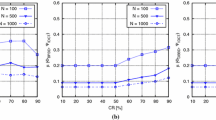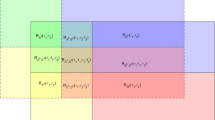Abstract
Compressed sensing (CS) is a promising theory that is able to measure signal below the Nyquist rate through measurement matrices. Random matrices are regarded as optimal measurement matrices to spread out signals to a small number of measurements. However, the random matrices cost too much memory space for implementation. The structured matrices are then proposed to reduce such enormous memory cost. Nevertheless, the recovery performance of the structured matrices suffers from severe degradation. In this paper, we propose sign-flipped scrambling method and extended-select scrambling method for circulant matrices to compensate the performance loss. The sign-flipped scrambling for circulant matrices is able to approach recovery performance of random matrices within defined guarantee region. On the other hand, the extended-select scrambling together with sign-flipped scrambling for circulant matrices is able to approximate the overall recovery performance of the random matrices. In addition, architectures are designed to realize the proposed scrambling methods. Compared with random matrices, proposed scrambling matrices are more cost-effective for implementation.















Similar content being viewed by others
References
Donoho, D. L. (2006). Compressed sensing. IEEE Transactions on Information Theory, 52(4), 1289–1306.
Baraniuk, R. G. (2007). Compressive sensing. IEEE Signal Processing Magazine, 24(4), 118–122.
Lustig, M., Donoho, D., & Pauly, J. (2007). Sparse MRI: the application of compressed sensing for rapid MR imaging. Magnetic Resonance in Medicine, 58(6), 1182–1195.
Jiang, W. & Yang, J. (2016). The rate-distortion optimized compressive sensing for image coding. Journal of Signal Processing System. [Online], pp. 1–13. Available: http://link.springer.com/article/10.1007%2Fs11265-015-1087-0.
Chen, C. Y., Wu, W. R., Gau, C. S. (2015). Joint AoA and channel estimation for SIMO-OFDM systems: a compressive-sensing approach. Journal Of Signal Processing System. [Online], pp. 1–15. Available: http://link.springer.com/article/10.1007%2Fs11265-015-1043-z.
Pfetsch, S, Ragheb, T, Laska, J, Nejati, H, Gilbert, A, Strauss, M, Baraniuk R, & Massoud, Y. (2008). On the feasibility of hardware implementation of sub-Nyquist random-sampling based analog-to-information conversion. Proceeding of IEEE International Symposium on Circuits and Systems, 1480–1483.
Chen, X., Yu, Z., Hoyos, S., Sadler, B. M., & Silva-Martinez, J. (2010). A sub-Nyquist rate sampling receiver exploiting compressive sensing. IEEE Transactions on Circuits System I, 58(3), 507–520.
Bajwa, W. U., Haupt, J.D., Raz, G. M., Wright, S.J. & Nowak, R. D. (2007). Toeplitz-structures compressed sensing matrices. Proceedings of IEEE/SP Workshop Statistics. Signal Process, 294–298.
Yin, W., Morgan, S. P., Yang, J. & Zhang, Y. (2010). Practical compressive sensing with Toeplitz and circulant matrices. Rice Univ., Houston, TX, CAAM Tech. Rep. TR10-01.
Tropp, J., & Gilbert, A. (2007). Signal recovery from random measurements via orthogonal matching pursuit. IEEE Transactions on Information Theory, 53(12), 4655–4666.
Duarte, M. F., & Eldar, Y. C. (2011). Structured compressed sensing: from theory to applications. IEEE Transactions on Signal Processing, 59(9), 4053–4085.
Candes, E. J., & Tao, T. (2006). Near-optimal signal recovery from random projections: universal encoding strategies? IEEE Transactions on Information Theory, 52(12), 5406–5425.
Rauhut, H., Romberg, J. K., & Tropp, J. A. (2012). Restricted isometries for partial random circulant matrices. Applied and Computational Harmonic Analysis, 32(2), 242–254.
Allstot, E. G., Chen, A. Y.,Dixon, A. M. R., Gangopadhyay, D. & Allstot, D. J. (2010). Compressive sampling of ECG bio-signals: quantization noise and sparsity considerations. Proceedings of IEEE Biomedical Circuits and System Conference, 41–44.
Acknowledgments
This work was financially supported in part by the Ministry of Science and Technology of Taiwan under Grants MOST 103-2622-E-002-034 & 104-2622-8-002-002, which are sponsored by MediaTek Inc., Hsin-chu, Taiwan, and NOVATEK Fellowship. Part of the technical contents in this paper was presented in part at the IEEE SiPS, Hangzhou, China, Oct. 2015.
Author information
Authors and Affiliations
Corresponding author
Rights and permissions
About this article
Cite this article
Lin, YM., Zhang, JF., Geng, J. et al. Structural Scrambling of Circulant Matrices for Cost-effective Compressive Sensing. J Sign Process Syst 90, 695–707 (2018). https://doi.org/10.1007/s11265-016-1189-3
Received:
Revised:
Accepted:
Published:
Issue Date:
DOI: https://doi.org/10.1007/s11265-016-1189-3




